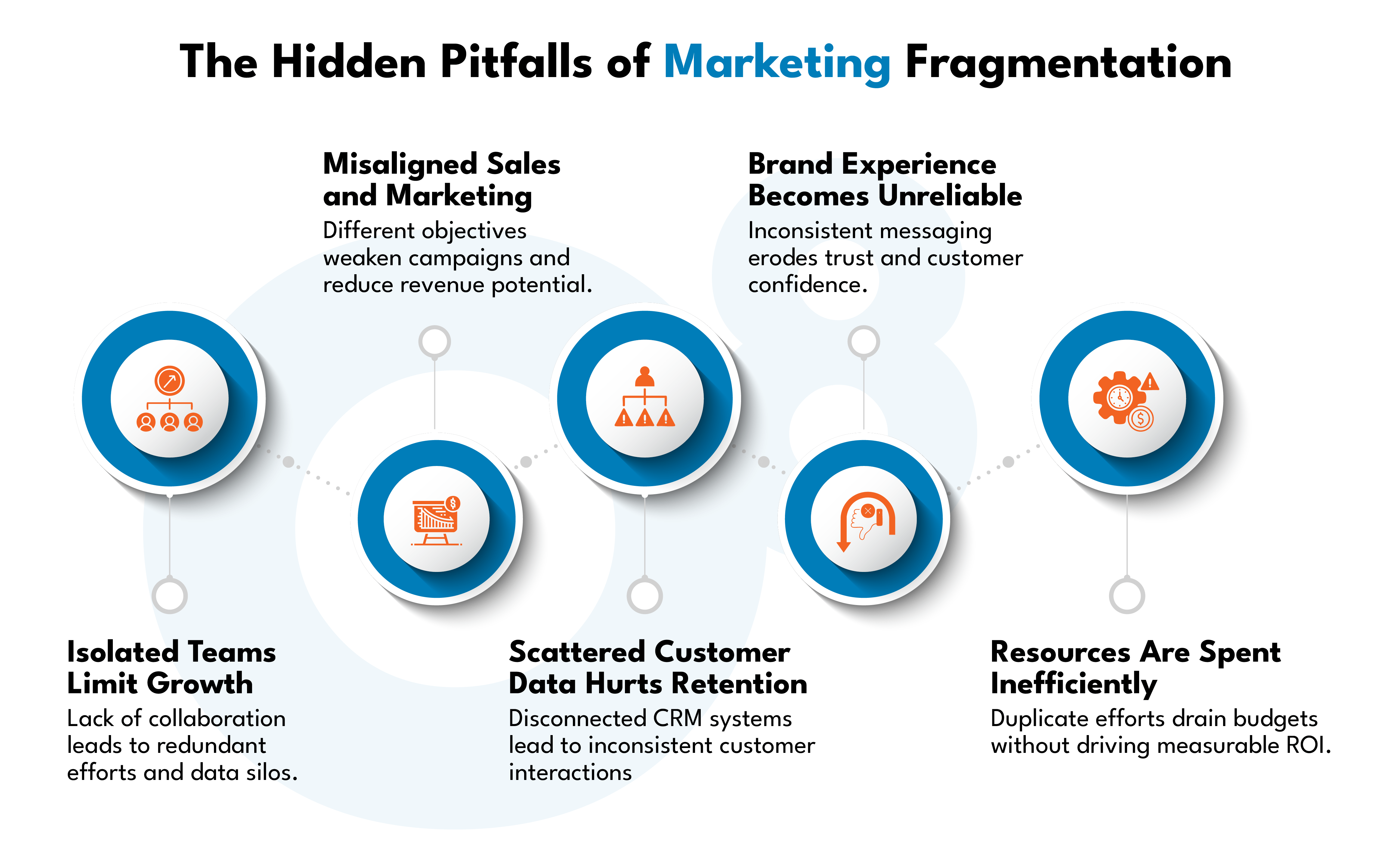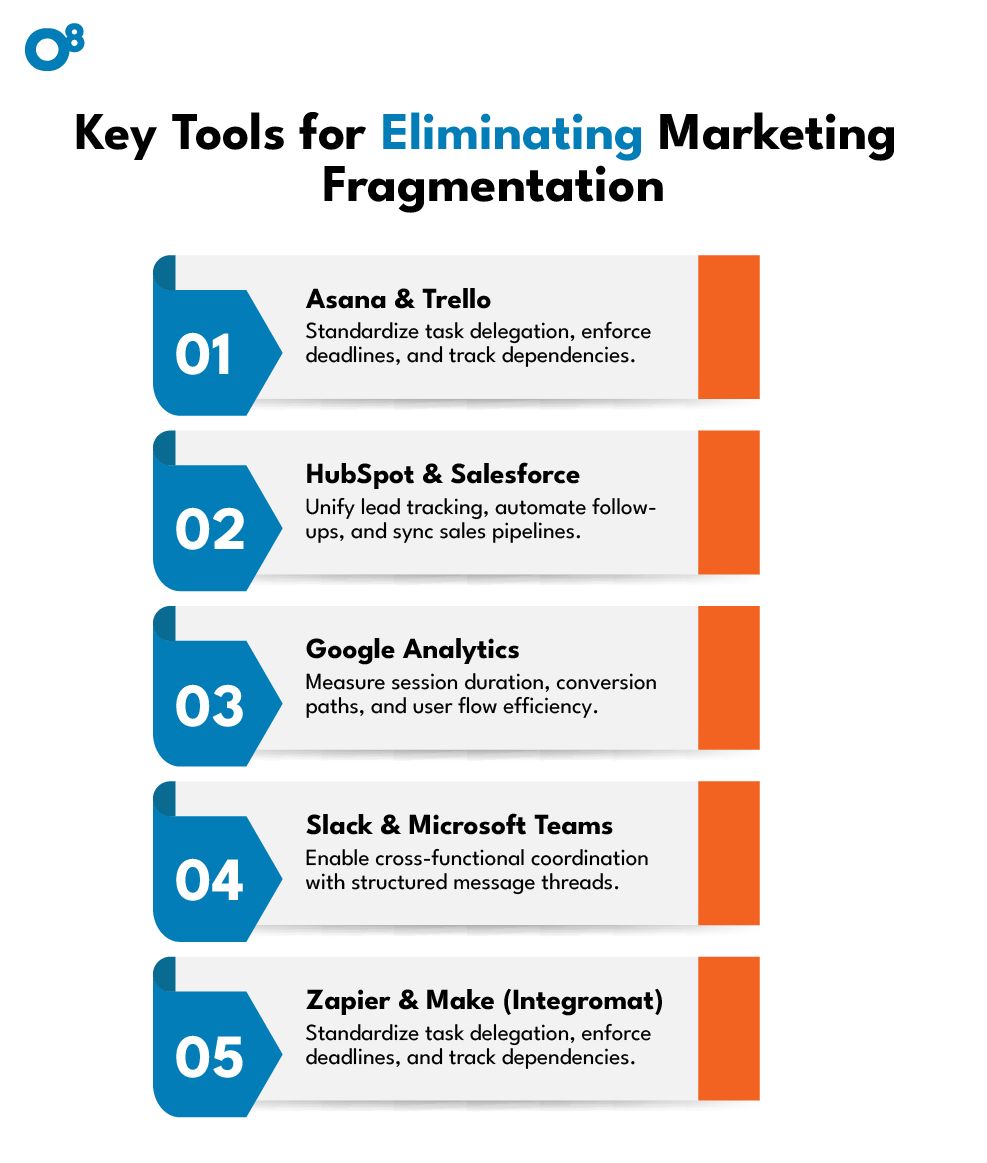Fix Your Fragmented Marketing with a Holistic Marketing Approach

- Fragmented or siloed marketing causes inefficiencies, wasted resources, and inconsistent messaging.
- Holistic marketing connects your teams, tools, and goals to align messaging and customer experience across all channels.
- When marketing and sales align around shared goals, businesses gain better leads, smoother experiences, and higher ROI.
- CRMs, project tools, and automation platforms like Zapier streamline workflows and support a connected customer journey.
- Reviewing strategy, using data, and adapting to trends keeps your marketing sharp and growth-focused.
Fragmented digital marketing is one of the most common and costly issues we help businesses solve at O8. We recently unpacked this topic on the Growth Gears podcast, explaining how disjointed marketing efforts across teams lead to inefficiencies, mixed messaging, and poor customer experience.
This blog pulls together some takeaways from our recent podcast episode on fixing fragmented marketing. The key theme remains our holistic marketing concept, one that connects internal marketing, real customer experiences, and an integrated marketing strategy, which can seriously shift what your marketing delivers.
How to Tell When Your Marketing Is Fragmented
According to Salesforce, 79% of customers expect seamless experiences across departments, yet more than half say it feels like they’re dealing with entirely separate companies across different online channels.
That gap isn't just frustrating for customers. Internally too, it leads to marketing and sales teams pulling in different directions, duplicating efforts, and delivering inconsistent messaging to the target audience.
Fragmented marketing often creeps in subtly, but it can cause substantial long-term damage to your overall marketing program and business growth. When left unchecked, it undermines brand consistency, drains resources, and breaks down stronger customer relationships before they can even begin.
One of the most critical concerns with fragmented marketing arises at the executive level:
“One of the biggest costs that I see is when C-level executives stop believing in marketing. They say, 'Marketing doesn't work, let's fire the marketing team, and let's throw 200 sales reps at the problem.' This creates a destructive, vicious cycle. Holistic marketing avoids this trap and significantly improves the health and psyche of your organization.”
- Seth Viebrock, CEO, O8
Here are some of the most telling signs your marketing initiatives might be out of sync.
Siloed Work: Internal Marketing Teams Operate Independently Without Shared Objectives
When your marketing departments function in isolation, without unified goals, it leads to inefficiencies and inconsistent messaging.
A Forbes report highlighted that 65% of marketers believe silos reduce campaign clarity—leading to fragmented customer journeys, low customer engagement, and inefficiencies that waste time and budget.
Data silos also drive up operational costs through duplicated efforts and disconnected reporting, hurting your ability to execute a truly integrated marketing campaign.
Disconnected Strategies: Product Roadmaps and Marketing Strategies Are not Aligned
If your product development roadmap and marketing aren’t synced, the disconnect shows up fast. It creates mismatched timelines, inconsistent messaging, and brand image confusion across channels. This weakens brand recognition and reduces the perceived brand value of your offerings.
As Zachary Ellison, one of our fractional CMOs at O8, said during the podcast, in day-to-day operation, this (fragmented marketing) seems like you're basically doing everything yet nothing gets done.
That confusion trickles down to your audience, impacting brand identity, brand consistency, and overall customer engagement. It becomes harder to build brand loyalty or even basic brand recognition when each piece of your Go-to-Market strategy feels like it was built in isolation.
Inability to Track ROI: Each Channel and Effort Prove Its Value
Without a cohesive strategy, tracking the return on investment becomes challenging.
You can’t track what’s working, optimize your budget, or make informed decisions. This lack of visibility makes it nearly impossible for marketers to prove the impact of their work, especially across diverse efforts like social media marketing, Google Ads, and direct marketing.
It’s a common issue in programs that don’t embrace digital marketing integration, where data flows freely, performance is tracked holistically, and strategy drives execution.
Reactive Approaches: Marketing Activities Become a Continuous Cycle of Firefighting Rather Than Proactive Planning
Fragmented teams often fall into reactive mode, constantly responding to problems instead of planning ahead. There’s no long-term vision, just short-term fixes. This firefighting approach leads to inconsistent messaging, scattered goals, and missed opportunities for real growth.
Instead, a holistic approach to digital marketing creates space for strategy. It allows teams to collaborate intentionally, align with broader business goals, and move from reacting to leading. This shift also strengthens relationship marketing, focusing not just on quick wins, but on building trust and long-term customer engagement across every touchpoint.
Reliance on a Single Marketing Channel: No Integration Across Multiple Marketing Channels
Focusing solely on one marketing channel limits your reach and leaves your strategy exposed. If that channel changes, whether it’s a drop in organic reach, rising ad costs, or a platform policy shift, your entire marketing funnel can take a hit.
Diversifying marketing efforts across multiple channels, like email marketing, social media, SEO, and paid ads, not only spreads risk but also creates more touchpoints with your audience. This omnichannel marketing approach supports consistent customer interaction and brand visibility.
Over-investing in a single channel can reduce ROI by 20-50%, whereas a balanced mix of brand and performance marketing can lift ROI by 25-100%.
Lack of Follow-up Plans: Strategic Pre-Promotion or Follow-up
This one’s easy to overlook. You launch something, it goes live, and then what?! Without a structured follow-up plan, even well-executed marketing initiatives fall short.
Whether you’re running a targeted direct marketing push or a full-scale digital marketing rollout, the follow-up is where conversions, and stronger customer relationships, actually happen. Neglecting follow-up strategies diminishes customer engagement over time.

The Fix: Shift Toward a Holistic Marketing Approach
Addressing these issues takes more than a few quick wins.
As our podcast hosts discuss, fixing fragmented marketing goes beyond simply having a shared system like a unified CRM. You need a blueprint, synced communication, and cross-departmental goals. Without those, it’s nearly impossible to manage relationships or deliver a cohesive customer experience.
A key issue discussed was the concept of internal marketing—how effectively communicating and aligning strategies within an organization can significantly influence overall marketing success.
It requires a shift toward a holistic marketing approach, one that connects your teams, aligns your message, and delivers real, measurable results through an integrated marketing strategy. The goal isn’t just better coordination, but creating a stronger, smarter foundation for long-term growth and truly connected customer experiences.
Is Your Current Marketing Agency Secretly Sabotaging Your Business?
Why Fragmented Marketing Hurts More Than You Think

When your marketing efforts are misaligned, the ripple effects reach every part of your organization, from budget and performance to team morale and brand perception.
Here’s how fragmentation shows up inside the organization:
Lost Efforts and Poor Measurement
Without consistent tracking, marketing activities become hard to measure. Tasks get repeated, deadlines slip, and no one has a clear view of what’s working. It drags down decision-making and leads to a bloated, inefficient system.
Missed Revenue
Fragmented strategies weaken your ability to link actions to outcomes, directly impacting ROI and long-term customer loyalty. When marketing goals are unclear or disconnected from business objectives, it’s harder to convert leads into customers.
Damaged Brand Perception
Inconsistent messaging across channels damages brand awareness and erodes trust. Customers experience a disconnected journey that undermines your brand identity and makes it harder to build lasting relationships.
Team Burnout
Without shared goals or cross-functional alignment, internal teams feel frustrated and directionless. Collaboration suffers, turnover increases, and teams lose sight of what success looks like. A strong, connected holistic strategy can reverse this trend.
Lower Conversion Rates
When marketing and sales aren’t aligned, the customer journey breaks down. Poorly timed outreach, mixed messaging, and a lack of follow-up all hurt your ability to convert interest into action—wasting budget and reducing results.
Wasted Resources Due to Duplicated Efforts
A lack of communication often means marketing initiatives get repeated or recreated unnecessarily. This is especially common when content marketing lives separately from sales enablement, leading to inconsistent tools, decks, and assets in customer-facing conversations.
Continuous Rebuilding
Without a clear integrated marketing communication strategy, teams are constantly starting over—rebuilding campaigns, reworking messages, and reacting to problems instead of preventing them. It’s exhausting and unsustainable.
As Thomas Zandstra,fractional CMO at O8, put it:
“You're building something without a blueprint, continually rebuilding as it falls apart. That’s what fragmented marketing feels like.”
The Fix: Aligning Marketing, Sales, and Customer Experience
Achieving alignment is crucial for a holistic marketing strategy and we can sum it up in 4 bullet points.
- Clearly Defined Goals: Develop a clear, comprehensive marketing strategy document outlining objectives and targets.
- Cross-Department Collaboration: Regular meetings and shared communication ensure teams are aligned.
- Unified Metrics and KPIs: Share performance metrics to align marketing management across departments.
- Streamlined Sales-Marketing Handoff: Clearly define processes to enhance customer experience during transitions from marketing to sales.
Integrating these practices fosters collaboration, enhances efficiency, and strengthens overall marketing efforts.
Essential Tools for Unified, Integrated Marketing
Quick disclaimer: Adding tools that promise to “integrate your marketing” won’t fix fragmentation on their own.
Unifying your marketing function means building an intentional, connected ecosystem that supports your holistic strategy, one where each support the system you build and your teams.
Here are a few foundational tools that support this kind of holistic marketing approach:
- Project Management Software: Tools like TeamWork, Trello, Asana help create clarity around roles, timelines, and dependencies. They keep teams organized, reduce duplicated efforts, and ensure that priorities stay aligned across the business.
- Customized CRM Software: Your CRM should be more than a contact database. It should act as your single source of truth, a place where you can track where customers are in the funnel, spot bottlenecks, and get real-time insights through dashboards that actually reflect your KPIs.
“Use a CRM you’ll actually use daily. It should be customizable, trackable, and something that speeds up your process.”
- Zachary Ellison, Fractional CMO, O8
We often recommend HubSpot for its flexibility, but whatever tool you choose—make sure it’s reliable, regularly updated and central to your workflow.
- Workflow Automation (Zapier): Tools like Zapier help automate repetitive tasks so your team can focus on higher-value work. Just don’t automate too soon. Let real data show you where automation makes sense. Our best advice is to allow our workflow automation to evolve over time, not all at once.
Long-term Benefits of a Holistic Marketing Approach
Now let’s quickly roundup what you can expect to change when you move from fragmented marketing to a holistic strategy:
- Improved Internal Marketing and Psychology: Teams work toward shared goals with clearer communication and a more unified mindset.
- Proactive Marketing Mindset: Problems are identified and addressed early, before they escalate.
Enhanced Customer Relationships and Satisfaction: Targeted efforts lead to deeper relationships and higher satisfaction. - Increased Executive Buy-In: Consistent results build trust and long-term support from leadership.
- Ongoing Optimization: Continuous data-driven improvements refine your overall marketing mix and performance marketing strategies.

FAQs
How can I tell if my marketing is fragmented?
Signs of a fragmented strategy include siloed marketing teams, inconsistent customer experiences, a lack of a unified CRM system, and difficulty in tracking ROI. If different departments are not aligned towards common objectives, it’s a clear indication of fragmentation.
What is a holistic marketing approach?
A holistic marketing approach brings all departments and teams together under one unified strategy. Instead of working in silos, marketing, sales, customer success, and leadership align around shared goals, clear communication, and a consistent brand message across all channels.
What are the benefits of aligning marketing and sales?
Aligning marketing and sales can lead to faster revenue growth and improved brand perception. When these departments work together, they create more cohesive campaigns and efficiently drive business results.
What tools can help unify my marketing strategy?
Key tools include project management software like Asana or Trello, cloud-based CRM platforms like HubSpot or Salesforce, and automation tools like Zapier. These tools facilitate seamless communication and integration across teams.
How often should I review and update my marketing strategy?
It’s advisable to review and update your strategy at least quarterly. Regular reviews allow you to assess performance data, adapt to market changes, and ensure that your strategy remains aligned with business goals.
Conclusion
Moving from fragmented to unified marketing isn’t just a systems upgrade—it’s a shift in how your team works together. A holistic marketing approach connects the dots between people, strategy, and execution so your efforts actually add up to something measurable and meaningful.
But here’s the catch: alignment doesn’t happen in isolation. It takes buy-in. You have to share results, communicate clearly, and help stakeholders, including leadership, see how marketing fits into the bigger revenue picture. It’s not about fixing everything overnight. It’s about building a connected system that improves over time.
That’s the kind of work we focus on at O8: helping teams turn scattered efforts into something strategic, trackable, and actually enjoyable to manage.
Want more insights like this?
Listen to the full episode and subscribe for expert insights on holistic marketing. Or browse all our episodes here.
Ready to Fix Your Marketing?
Let’s turn scattered efforts into a smart, unified strategy.








